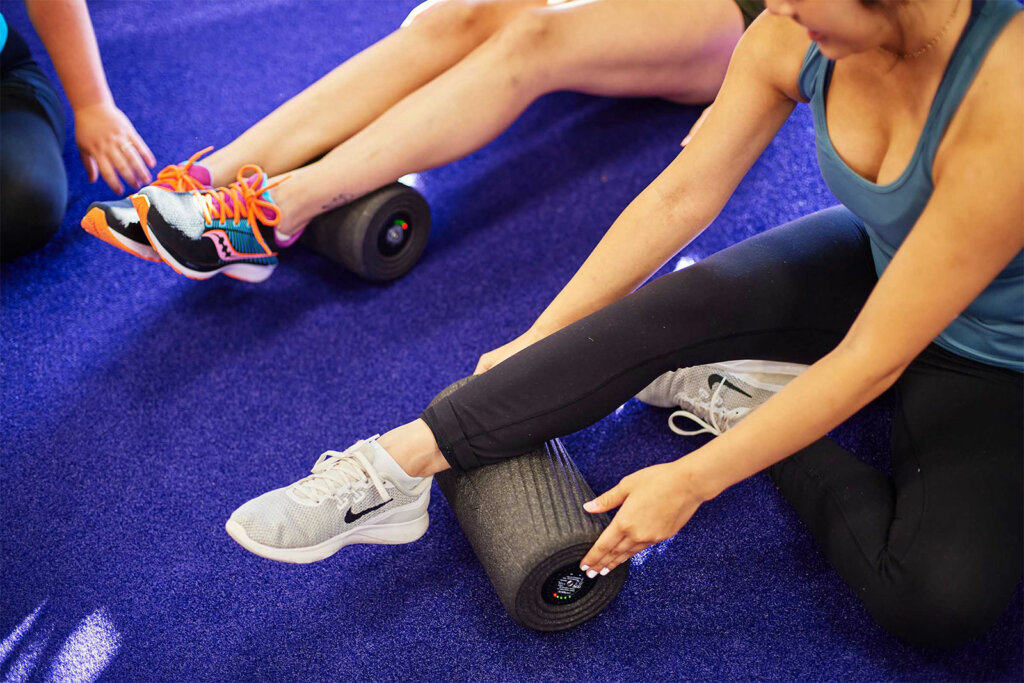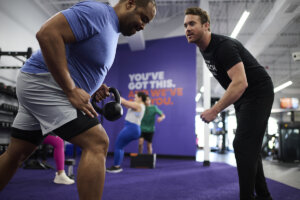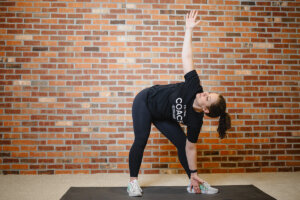What is something that you love to hate? For us, it’s muscle soreness, aka DOMS (delayed onset muscle soreness). It’s the burn that hurts so good. But for those of us who would like to help speed up the recovery process, there are steps to take that will help. In fact, the best time to think about sore muscles is before they’re even sore! That’s right — proper recovery starts before you swipe that gym card or fire up your fitness tracker.
7 ways to relieve sore muscles after a workout
There are things you can do in your daily life to bring relief to sore areas as well as reduce muscle soreness in the future.
1. Stay hydrated AF
Staying hydrated is one of the best ways you can practice self-care. The importance of drinking water simply can’t be overstated; our bodies are made of anywhere between 60% and 70% water, and it’s critical to metabolism, digestion, and more:
- Water helps muscles by bringing nutrients before, during, and after a workout, which improve muscles’ ability to perform during and build back after exercise
- A fully hydrated body brings more blood flow to muscles during activity, leading to less muscle soreness and fewer incidences of cramping
- Water helps keep your joints protected and can help prevent joint damage
- Water maintains all of your tissues, meaning stronger bones, healthier skin, and less brain fog
- Water helps your digestive system be as efficient as possible at absorbing nutrients from your food intake as well as eliminating wastes
The key to being hydrated is an “always-on” mindset, meaning it’s better to get your ounces in over the course of a day versus chugging a 32-ounce bottle right before you hit the gym. The great news is that consistently hydrating is not as complicated as it seems. We recommend habit stacking your water intake: Essentially, you’ll link it with other daily habits. For example, any time you get up to go to the bathroom, you’ll drink half a glass of water. Or, when you brush your teeth at night or in the morning, you’ll drink a full glass of water.
How much water should you be drinking, you ask? We’ve got a full hydration rundown here.
2. Fuel your muscles with food
They say “you are what you eat” — and it turns out there’s some truth to it. What you put into your mouth gets broken down by your digestive system and sent directly to your body tissues, where it’s used for energy as well as for raw materials that help with tissue repair. So, you’re looking to optimize performance as well as results, look no further than your kitchen.
Pre-workout nutrition
The best foods to take in before you exercise are rich in healthy carbs and lean protein. You may be aware of the different types of carbohydrates, simple vs. complex. In essence, simple carbs — such as sugars found in fruits — are absorbed and used quickly by the body. Complex carbs — like those found in grains — take a little longer to get in our bloodstream. For this reason, the type of carb you pick for your pre-workout meal or snack will depend on how much time you have before you need to get started.
Only have a short window to eat? A piece of fruit will be a fantastic option! If you have a little more time or are doing an endurance workout, complex carbs such as a turkey sandwich on whole-grain bread will be a better fit.
Here are a few of our faves:
- Banana berry green smoothie
- Protein shake
- Peanut butter energy bars
- Granola or protein bar
- Handful of berries
For more, check out our Coach-Approved Pre-Workout Snacks.
Post-workout nutrition
That feeling when you realize your workout is done and dusted — priceless! Nothing compares to the boost you get when you make it through a particularly challenging circuit. Maybe you hit a PR! Or, you had one of those days where simply making it to the gym was a success. One thing is for sure: When your body is done doing the hard work, it’s time to replenish it.
During your workout, you burned through the energy stores that were in your bloodstream and muscle tissues (the energy for those burpees had to come from somewhere, but who would’ve thought it was from your PB&J?). This means that after your workout, you need to refuel in order to feel your best and get the most out of the sets and reps you just did, or miles you ran, or meters you rowed. It’s not only the ultra-endurance athletes that need to think ahead about post-activity food choices.
Luckily, you’ve got a coach on your side, and we’re here with our top picks for post-workout eats! In the end, the most important thing is that your meal is rich in protein from lean sources (a big fatty burger is not ideal, but ground turkey tacos are) and that you’re taking in carbs to resupply yourself with energy for the rest of your day. Some tasty options:
- Double chocolate chunk protein bites
- Protein-packed piña kale-ada smoothie
- Any variation of a lean meat paired with vegetables
More inspiration for your next post-workout fuel-up can be found here.
Pay attention to nutrient timing
Before we button up this discussion on pre- and post-workout nutrition, we need to make sure we remember the goal: to help muscles recover and relieve soreness. This comes down to taking in food during the optimal time frame, both before and after your sweat sesh.
While it’s true that you don’t need to be perfect at everything to see progress toward your goals, you can see a boost in recovery and results by planning ahead and being prepared.
Check out our complete resource on nutrient timing.
3. Do not skip the cooldown
Have you ever reached the end of your workout and made a beeline for the exit door? Maybe you sat in your car staring off into the distance while you reflected on how you just CRUSHED it! (Or did the workout crush you? Maybe both!)
The only problem with this is that while you’re basking in the post-workout glow, your blood is still pumping through your veins from head to toe, and if you’re seated and not moving around, you run the risk of allowing that blood to pool in your tissues, leading to all sorts of “no-thank-you’s” like tightness and knots.
A simple solution is to not skip your cooldown. Be mindful of what your body is doing when your heart rate is coming down and your breathing is returning to a regular pace.
If you haven’t picked up on the theme yet, we’ve got you covered at every turn. Peep this Ultimate Post-Workout Checklist for a step-by-step list of things to do between the time you finish your workout and the time you leave the gym. You’re so welcome, #AFFAM!
4. Become a foam-rolling pro
Foam rolling is so versatile because you’ll benefit from doing it before you work out to prime your muscles and joints, as well as after your workout, where the benefits are geared toward a proper recovery. Taking the time to foam roll from upper-back to calves — or at least the sore areas — is one of our favorite self-care tips that never goes out of style. A great hack is to have a foam roller handy in your home so you can use it when you’re catching up on your favorite shows, right upon waking, or before going to bed.
If the best (or only) time for you to foam roll is at the gym, you’ll get major benefits, including:
- Improved blood flow to your muscle tissues during your cooldown
- Released tension and adhesions in the fascia (the layer of tissue between your muscles and your skin, where tightness often lives)
- Decreased muscle soreness later on (remember our old friend DOMS?)
Foam rolling also helps with prevention, so do your future self a favor and spend 5–7 minutes foam rolling after you finish your workout.
Check out our Foam-Rolling 101 article, and find our favorite upper-body and lower-body foam rolling moves here!
5. Stretch, stretch, stretch for soreness prevention
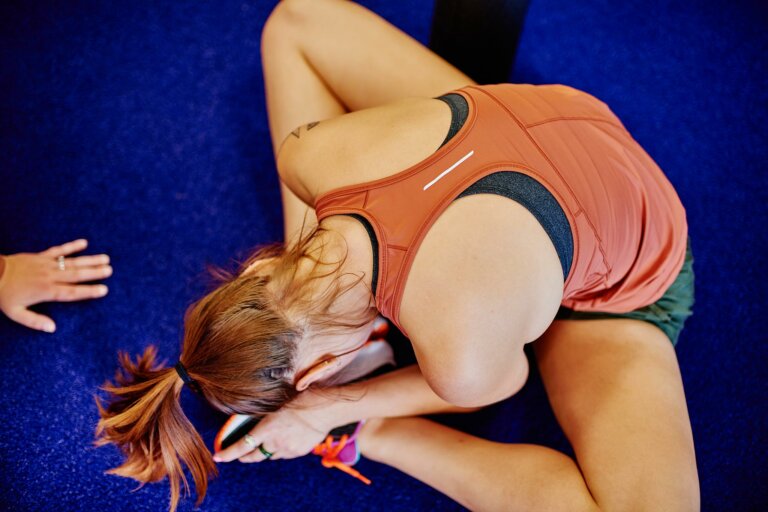
Okay, we admit that doing your stretches might not be the highlight of your workout. But just because it’s not the “main event” doesn’t mean it’s not vitally important. It’s easy if you have a batch of stretches that you have memorized — that way, you’ll never be able to say, “I wasn’t sure what to do for a warm-up!” As Coaches, we’ve heard it all, and we’re here with solutions.
Warm-up stretches
There are many reasons to spend 5 minutes or more on your warm up, but one of the most important is to get yourself in the zone. Yes, we’re talking mentally! Jumping right into your circuit can be jarring for your body and your brain, so we recommend taking time to let your mind and your muscles warm up to the idea. Priming yourself now will translate into better performance — not to mention you’re less likely to cramp or get injured.
Here are our favorite warm-up stretches to do before your next workout!
Post-workout stretches
If flexibility is what you’re after, the post-workout window is your time to shine. You don’t have to be a professional yoga instructor or a gymnast to be flexible — you can work on it over time. Stretching after your session is dual-purpose: Your muscles get a little more flexible and you can focus on breathing while holding the stretches.
Here are our top cool-down stretches!
6. Take rest days to prevent sore muscles
Who started the misconception that a day without exercise is unhealthy? We’d like to speak with the manager, please! Let’s go ahead and debunk this myth once and for all. Repeat after us: Rest is a silent workout. That’s right! If you’re walking funny, saying “ouch” every time you sit down, or remembering those shoulder presses every time you turn the steering wheel, trust your instincts, listen to your body, and consider taking a day off.
Not sure how to know if you’re still in the recovery phase, or if you’re just tired? Here are our top five signs you need a rest day.
7. Practice active recovery
Taking a rest day doesn’t mean you have to stay home and stay on the couch. Instead, look for ways to practice active recovery, which can help relieve (and even prevent!) muscle soreness, as well as loosen up areas that feel tight.
What is active recovery? It’s when you’re helping your muscles recover by staying active, but not to the level of intensity that you usually reach when you’re exercising.
Don’t get us wrong, we’re all about snuggling up on the couch with a bowl of popcorn with our favorite Netflix show. When your body is recovering, however, it’s best to avoid becoming one with your sofa for an extended period of time. It’s okay if you don’t get your 10,000 steps in on your recovery days, but try not to be a total couch potato. Get up and move around periodically (at least once every 20 minutes). Do some total-body movements such as bodyweight squats, jumping jacks, or even push-ups. Some other ideas include:
Go for a walk
Indoors, outdoors, treadmill, pavement… What’s the best choice? It’s the one that you’re most likely to do consistently! Taking a walk does wonders for circulation, digestion, and mood. See you on the trails!
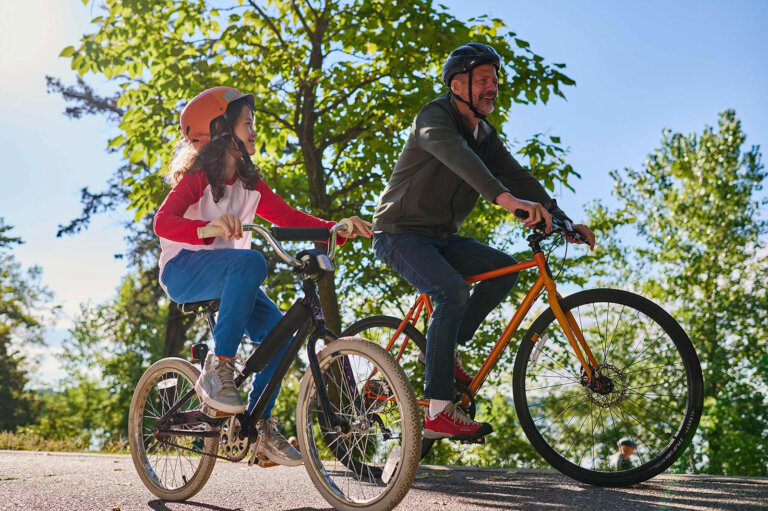
Play with your kids or pets
The benefits of play with kids or pets goes beyond your muscles, which is the most beautiful part of this active recovery option. Don’t feel guilty for doubling up on physical self-care in the form of playtime with those you love! In fact, we think it’s genius!
Do dynamic stretches
Stretches that involve movement are called dynamic stretches, and they fit perfectly in your recovery routine. A classic example is the Inchworm, which goes as follows:
- Stand upright with your arms by your sides
- Bend forward at the waist, hinging at the hips, and place your hands on the floor in front of you, right in front of your feet
- Walk your hands out until your body is straight in a plank position
- Walk your hands back in and return to an upright standing position
This exercise works your shoulders, lower back, and hamstrings, which are common sites for soreness and tightness.
Practice yoga
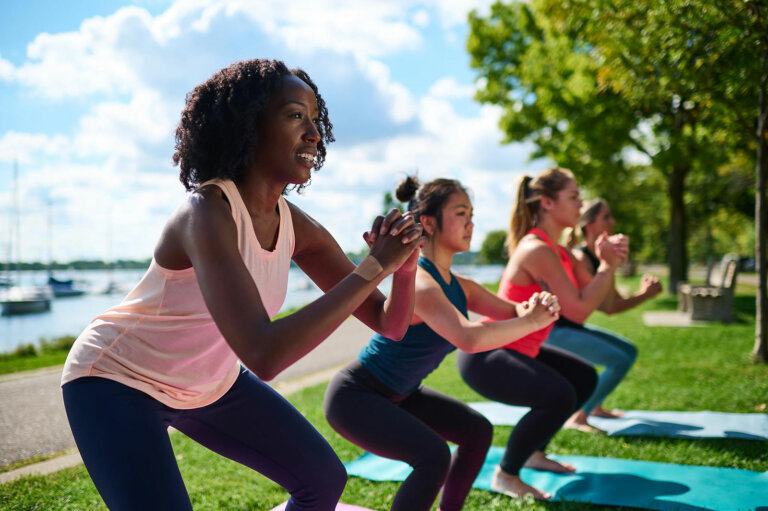
Yoga is for everybody! While it might seem like something that requires a lot of natural talent, flexibility, or balance, yoga can be done by just about anyone in the comfort of your own home. We recommend these beginner-friendly yoga poses to help you get comfortable with your practice. During yoga, you’ll focus on your body and your breathing, making it an ideal activity for an active recovery day. Bonus: Yoga can lower your cortisol levels and help you stress less.
Get a massage
Getting a massage from a professional is the poster child of self-care, and for good reason. Deep-tissue massage promotes the release of soreness and tension from your body. Did you know that massage also helps your body get rid of toxins that have been stored away in your tissues?
Another option is to check out percussion devices, which can be used before and after workouts to help enhance performance and relieve sore or tight muscles.
Do low-impact movements
If you’re just itching to exercise but it’s your day to focus on recovery, we aren’t going to chain you to the sofa or put you in a straight jacket — go ahead and have at it! A strategy that you can use to stay moving but show your recovering body some love is to do low-impact exercise. This involves movements such as swimming, riding a bike, or using the rower. Not sure what constitutes low- versus high-impact? This explainer will walk you through the difference.
Alright team, consider yourself equipped to handle all the soreness your next workout might throw your way. With some planning and preparation, you’ll be able to bounce back into the gym before they even knew you were gone!
Want more post-workout inspiration? Check out our Ultimate Post-Workout Checklist.
